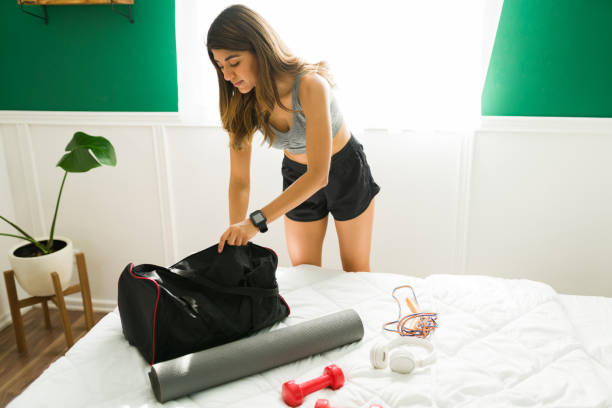
The start of a new day often brings a sense of renewal and potential. However, for those navigating the complexities of ADHD, the seemingly simple act of getting out of bed can be a monumental task. Mornings become a battleground where the mind’s perpetual dance with distraction and restlessness can overshadow the desire to face the day ahead.
Between the mental load of facing the day and the physical repercussions of ADHD, such as restless sleep due to anxiety and/or reduced sleep due to staying up late with revenge bedtime procrastination, you may find yourself thinking, “I can’t get out of bed in the morning.” Before long, this fatigue becomes an overwhelming daily pattern that leaves you feeling further and further behind on catching up, finding balance, and creating a confident approach to your day.
How ADHD Can Make it Hard to Get Out of Bed in the Morning
Living with ADHD means navigating a world where focus and attention can be elusive, and mornings are no exception. The very nature of ADHD often leads to difficulties in establishing and maintaining routines, making mornings a particularly challenging time. The mind may race with thoughts, making prioritizing tasks and initiating action hard. Additionally, the struggle with executive functions, such as planning and organizing, can contribute to a sense of overwhelm, further complicating the process of starting the day.
5 Ways to Overcome ADHD When Getting Out of Bed
1) Establish a Consistent Routine:

Routines are the backbone of ADHD treatment. When it comes to going to bed and waking up, a consistent sleep routine can be difficult to stick to but also easiest to stick to once the body is on board. Your body wants a sleep pattern; it benefits enormously from a set bedtime and waking time. To facilitate this process, set specific wake-up and bedtime routines, incorporating activities that ease the transition from being awake to falling asleep to wakefulness.
Before bed, set your worries at ease by following the same procedures every day. This might include reviewing a checklist for the following day, journaling, setting aside electronics, and setting up for the next day (such as laying out clothing). Whatever it takes to free your mind of worries, fears, and/or fixations will contribute to your ability to fall asleep in a timely manner. Creating an environment where you can decompress and relax toward sleep will allow you to fall asleep at roughly the same time most nights. This makes it easier to wake up at the same time the next day.
Consistency can act as a stabilizing force, making mornings more manageable. If you always have the same amount of time in the morning to achieve what you need, then you are less likely to forget something or feel as though you are scrambling. Whatever time you need to wake up to achieve all your morning tasks, make sure you set your alarm for it. If you have a schedule where your daily obligations start at different times of the day, wake up in time for your earliest start.
Something you probably struggle with when it comes to your ADHD is getting sidetracked or procrastinating because you think you’ve got a ton of extra time to achieve your plan. To avoid misestimating your time on the days when you are awake earlier than you “need” to be, schedule a task like laundry, a meditation exercise, a fitness class, or anything that fits into that extra time. Set a secondary alarm to go off however long before your first appointment of the day, and commence your daily preparation routine at that time.
For example, if you have to wake up at 6:00 a.m. on Mondays to make it to work by 7:30 a.m., then you have an hour and a half to spend on your day’s preparations. On Tuesdays, if you work at 8:30 a.m., your alarm will still go off at 6:00 a.m. for you to get up and spend an hour as needed. You will set a second alarm for 7:00 a.m. and commence your daily preparation routine at that time.
2) Break Tasks into Manageable Steps:

Part of getting up and getting out of bed in the morning is dismantling your tasks and plans so that they do not feel overwhelming. If you’re laying in bed thinking, “I have to clean the house today,” you will not likely feel excited to start. Instead of looking at your day or your goals as a whole, view them in pieces. Break down tasks into smaller, more manageable steps. Create a checklist or visual schedule to guide you through the morning routine.
For example, if you know you want to go to the gym in the morning, there are components that you will need to have in place. You may have packed your gym bag the night before. Part of your checklist might be to double-check your work, although ideally, in time, you will learn to trust yourself that if your bag is in a certain spot by the door and all zipped up, it is ready to go. If your bag isn’t already packed, and you are feeling a little bit sluggish, or you’re worried about the time crunch, you may feel that getting yourself together and getting out the door isn’t worth it. Having a checklist allows you to organize yourself. Essentials: keys, gym pass, lock for locker (if applicable), headphones and music (if applicable), water bottle. You may also choose to change at the gym, or your gym might have a rule about outdoor shoes. You can also include what you are wearing on your list; maybe your gym runners are always in your bag, and the rest doesn’t matter to you. Everything you just organized constitutes one item on your agenda: going to the gym. Breaking it down into smaller pieces allows you to take one item at a time to get you out the door and on your way to your plans!
Determining how best to approach tasks is something we help our patients with here at our practice that offers ADHD treatment in Woodland Hills. What constitutes a “small” task will vary from person to person. You may also have ideas about what you are taking on to unpack; what stories are you telling yourself about what you have to do and how you are achieving it? If you resist taking your plans apart because you are telling yourself that you “should be able to just do it” or that you “should be embarrassed that you need to approach it this way,” you’re not going to benefit.
3) Incorporate Stimulating Elements:

Do your best to avoid getting onto your phone when you first wake up. Like doom scrolling before bed, it can be de-motivating and anxiety-causing to start your day watching curated posts or seeing real-time footage of distressing world events. Aim to set aside social media for a decent number of minutes in the morning, beginning instead with self-focus and self-care. The instant gratification of scrolling can be especially tempting to folks who have ADHD but ultimately fail to support the behaviors that are most beneficial.
Instead, integrate elements into your morning routine that engage your senses and promote alertness. Once you know that you are set and centered for the day, give yourself a boost. This could include listening to energizing music, exposing yourself to natural light, or incorporating physical activity. Utilize your five senses as much as you can and think of what makes you feel invigorated. Citrus scents? Bright colors? Upbeat tunes? Fresh clothing on your body? Your favorite coffee? Have you tried a five-minute dance party? Choose an artist who inspires you or a song that makes you feel powerful. Play it for yourself. Do a pretend concert in your kitchen. Circle your wrists, bend your knees, stretch your arms. Your body is going to be with you throughout all your tasks of the day; say good morning to it. Enjoy moving it. Thank it for another day together.
4) Use External Supports:

Consider using alarms or reminder apps to prompt you through your morning routine. Anything that needs to be completed at or by a certain time can use an alarm. Make sure that your supports are impossible to ignore, such as alarms on your phone or something you will be forced to look at right away. Visual cues, such as sticky notes or checklists, can serve as tangible reminders and also allow you to reassure yourself that you haven’t forgotten anything. Being able to regard your plan as a whole is a great tool; it helps lower anxiety and provides the structure you need to stay on track.
It is also useful to utilize ADHD supports that help you to manage your ADHD overall, such as ADHD therapy. Not only can ADHD make organization, planning, and decision-making difficult, but the accompanying depression that often coexists with ADHD can reduce energy, motivation, and optimism. Acute depression can come from shame, frustration, and a feeling of defeat related to the way ADHD symptoms manifest in your life. It may also be its own separate diagnosis, which requires therapeutic treatment and, potentially medication. The best way to work through these corresponding illnesses is to treat them individually and as a package. The support of a therapist can help you to identify behaviors, patterns, triggers, and useful tactics. Therapy is also a safe space to talk about your frustrations and fears with someone who understands the validity of your struggles and who is trained and consenting to take them on.
That is not to say that your friends and family cannot be part of your support network. Loved ones can be recruited to help you participate in your life. For example, if you are striving to get up at the same time every day, but some days you don’t actually have somewhere to be, you can make a plan with a friend or family member. Maybe you sign up for a regular event, like taking a class or going for a hike, or maybe that is the time you reserve for coffee dates with various loved ones. If you live with a partner or roommate, even something as simple as scheduling brunch together once per week can give you a routine to look forward to that also helps you to have structure in your day and a reason to be consistent in your sleep pattern.
5) Practice Mindfulness and Breathing Exercises:

Incorporate a brief mindfulness or deep-breathing exercise into your morning routine to center your mind and promote a sense of calm. A staple of therapy for ADHD is finding methods of relaxation and utilizing tools for focus and clarity. An ADHD therapist can help you identify where and how to apply mindfulness to your daily life. To begin with, mindfulness is about taking note of the happenings in our lives while trying not to attach judgment to what we discover. This helps us remain present, combating ruminating about the past or worrying about the future.
At first, intercepting these worrisome thoughts may feel like a monumental task. You may want to come up with some affirmations for yourself, such as, “I am fully prepared for this moment,” or, “I am focused on my current task.” “I have set my alarms for the day” or “My checklist is up to date” can also be helpful reminders. The point is to reassure yourself that you are on top of your plan.
Utilize your practice throughout the day; practice makes progress. When you get used to your practice, you will find it easier to employ in the morning, especially when you experience anxiety and decision paralysis. Mindfulness and breathing can also help you improve your sleep, thereby making mornings easier. You may want to meditate before bed, focusing on how your breathing relaxes your body for sleep. As you prepare for bedtime, helpful affirmations might include, “I completed everything I could for today,” and/or, “I am prepared for tomorrow.”
While taking action to make your morning routine easier, remember that there are bound to be mornings that get away from you. There is no such thing as an overnight transition followed by zero setbacks. By being mentally prepared for some mornings to be tricky, you are mentally prepared to recover from those mornings. Being blindsided is hard on the nervous system. Be kind to yourself, be realistic, and also be optimistic. Speak to yourself about small milestones, about learning from your trial and error, and about what is within and what is outside of your control. Give yourself space to adjust your routine as your life evolves. Remember that you are allowed to discover your way of doing things; it might not line up with how your friends or family achieve their goals. As long as it works for you, it works!
ADHD Treatment at Embracing You Therapy
ADHD isn’t all about hyperactivity and impulsivity when most people with ADHD struggle with organization and time management skills. When you are seeking therapy for ADHD in Woodland Hills, the goal is to assess the exact symptoms of your ADHD so that our skilled therapists can create action plans that best manage your ADHD traits.Contact us today for your complimentary 20-minute phone consultation with our Admin Team today!




